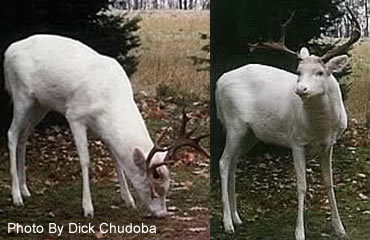Deer Talk

Whitetails, especially does and fawns, sometimes communicate by bleating like a lamb or bawling like a calf.
Bucks and mature does also snort, and a buck’s snort is often characterized by a kind of whinnying or whistling.
Very little communication among white-tailed deer is vocal, but they do vocalize more than most people realize and in a variety of ways. Adults or fawns may groan in complaint when they are restrained. Fawns may bleat to call their dams (mothers), and bucks occasionally bleat when chasing does during the rut.
The deer sound most commonly heard by people is the familiar snort and foot stamp when the animals are disturbed or frightened.
Whitetails are sensitive to sound and smell. Their large ears are constantly alert, and they depend on their acute sense of hearing to monitor the whereabouts and behaviors of other animals, including predators.
Their sense of smell also helps deer identify individuals. Individual recognition occurs in through scents produced as tarsal pheromones.
Smell attracts whitetails to food. If food smells good, the deer taste it. If it tastes good, they eat it. The senses of smell and taste enable deer to detect differences in palatability of forage.
Smell is also what attracts white-tailed bucks to does in heat.
Deer Colors

Albino deer are white and as rare as gold.
If you ever see an all-white deer in the woods, you will be very lucky. These deer, called albino whitetails, are quite rare. Only one deer in 100,000 is born this way, say biologists. Chances of seeing one in the wild are very low. It might be easier finding a rare coin or a gold nugget in a stream.
So rare are albino deer that generations of American Indians thought them to be magical. The Indians had no way of knowing that all living things have cells, and within those cells are chromosomes and genes. Genes are what make us unique.
Albino deer have recessive genes. Both parents must carry the gene to have an albino fawn.
Another reason albino deer are so scarce is that few survive to become adults. Unlike normal fawns born tan-colored with spots that help conceal them, all-white albino deer stand out in the woods. They are easily caught and eaten by predators. Albino whitetails also have poor eyesight, which further reduces their chance of survival.
Not every white deer you see is an albino. True albino whitetails have pink eyes and light-colored hooves. Many hunters see what they think are albino deer but are actually piebald whitetails. These animals have white as well as dark patches of hair in various amounts. Piebald deer are much more common that albino deer.
The opposite of albinism in whitetails is melanism. Melanism means an increased amount of black or nearly black pigmentation of skin, feathers or hair. Dark or even black deer are said to be melanistic. These deer have too much pigment in their eyes, hair and skin, rather than too little.